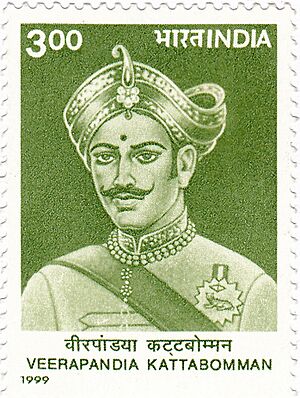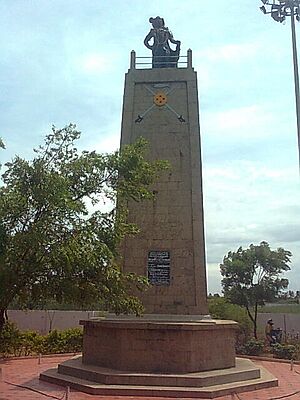Veerapandiya Kattabomman facts for kids
Quick facts for kids Veerapandiya Kattabomman |
|
|---|---|
| Palaiyakkarar of Tenkasi | |

Veerapandiya Kattabomman on a 1999 stamp
|
|
| Reign | 1792-16 October 1799 |
| Born | 3 January 1760 Panchalankurichi (in present-day Thoothukudi District, Tamil Nadu, India) |
| Died | 16 October 1799 (aged 39) Kayatharu (now in Thoothukudi District, Tamil Nadu, India) |
| Spouse | Jakkammal |
| Father | Jagaveera Kattabomman nayakar |
| Mother | Arumugathammal |
Veerapandiya Kattabomman was a brave leader and ruler from the 1700s in a place called Panchalankurichi, India. He was known as a Palayakarrar, which was like a local chief or governor. He stood up against the powerful British East India Company, who were trying to control more of India. Sadly, he was captured with help from another ruler and was hanged at Kayathar on October 16, 1799, when he was 39 years old.
Contents
Who Was Veerapandiya Kattabomman?
His Early Life and Family
Veerapandiya Kattabomman was born on January 3, 1760. His parents were Jagaveera Kattabomman Nayakar and Arumugathammal. His family was of Telugu origin.
His father, Jagaveera, was the polygar (another name for Palayakarrar) of Panchalankurichi. This meant he was in charge of the area. Veerapandiya belonged to important families called Bommu and Aathi Kattabomman.
Becoming a Leader
When Veerapandiya turned 30, he took over his father's position. He became the 47th polygar of Panchalankurichi. This was a big responsibility.
To get the support of the local Tamil people, his father had given him the name Pandiya Kattabomman Nayakar. The shorter name "Veera" came from his father's name, Jagveera.
Why Did Kattabomman Fight the British?
Understanding the Conflict
As a polygar, Veerapandiya had the right to collect taxes and gather soldiers in his area. But the British East India Company saw polygars as not being proper rulers. They wanted to take away their power to collect taxes and control their influence.
So, the British started a new tax plan. They wanted to collect taxes directly, without the polygars in the middle. Kattabomman saw this as an attempt by the British to take over his land and power.
The Tax Dispute
Kattabomman stopped paying taxes to the British. He argued that his taxes should be cancelled because his area had suffered from a long drought. At the same time, he was fighting against other polygars who were working with the British.
In 1798, Kattabomman and the British tax collector, Jackson, had a disagreement about unpaid taxes. Three months later, Kattabomman met Jackson in Ramnathapuram. During this meeting, there was a fight between the British soldiers and Kattabomman's men. A British officer named Clarke died. After an investigation, Kattabomman was found not guilty of this death.
However, in 1799, Kattabomman refused to meet with the collector again. So, the British sent an army led by Major John Alexander Bannerman to deal with him.
The Fight for Freedom
Battle at Panchalankurichi
Kattabomman had to defend his fort in Panchalankurichi. He was not fully ready for a big battle. His forces were able to stop the British army at first. But his fort was not strong enough to stand against British cannons.
So, he left the fort and went into the nearby forests. From there, he fought a guerrilla campaign. This means he used surprise attacks and hid in the forests to fight the British.
Capture and Execution
Kattabomman was captured on October 1, 1799. This happened with the help of polygars who were allied with the British. These included Ettappan of Ettaiyapuram and the king of Pudukkottai, Vijaya Raghunatha Thondaiman.
After his capture, Kattabomman was questioned for 15 days. He was then sentenced to death. He was executed by hanging at Kayathar on October 16, 1799.
What is Kattabomman's Legacy?
A Hero in History
Historian Susan Bayly says that Kattabomman is seen as a hero, much like Robin Hood, in local stories. Many traditional songs and poems, called kummi verses, tell his story.
The place where he was executed, Kayathar, has become a very important local memorial. People used to even sacrifice sheep there.
Memorials and Honors
The government of Tamil Nadu rebuilt the Panchalankurichi fort in 1974. The government also keeps a memorial at Kayathar. The remains of the old fort at Panchalankurichi are protected by the Archaeological Survey of India. In 2006, a festival was held in Panchalankurichi on his birthday.
In 1959, a Tamil-language film called Veerapandiya Kattabomman was made about his life. The famous actor Sivaji Ganesan played him.
To remember 200 years since his hanging, the Government of India released a postal stamp in his honor on October 16, 1999. The Indian Navy communications center at Vijayanarayanam is named INS Kattabomman after him.
See also
- Puli Thevar
- Dheeran Chinnamalai
- Maruthu Pandiyar
- Veeran Sundaralingam
- Oomaithurai, Veerapandiya Kattabomman's younger brother
- Rani Velu Nachiar
- Marudhanayagam Pillai


